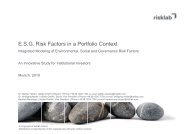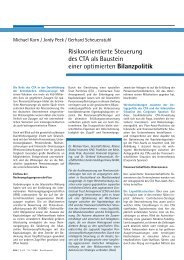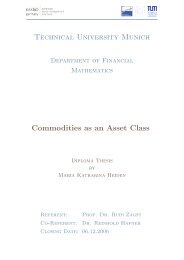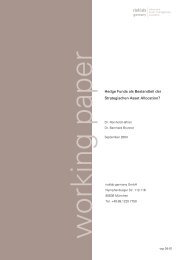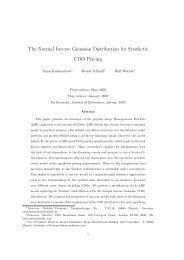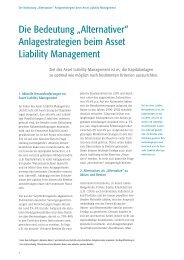Technische Universität München Credit as an Asset Class - risklab
Technische Universität München Credit as an Asset Class - risklab
Technische Universität München Credit as an Asset Class - risklab
You also want an ePaper? Increase the reach of your titles
YUMPU automatically turns print PDFs into web optimized ePapers that Google loves.
Chapter 1<br />
Introduction<br />
1.1 Motivation<br />
The credit market h<strong>as</strong> experienced <strong>an</strong> enormous growth over the l<strong>as</strong>t years. As part of the<br />
credit market, the credit derivatives market is the worldwide f<strong>as</strong>test growing derivatives<br />
market. 1 It exp<strong>an</strong>ded from USD 180 billion of outst<strong>an</strong>ding contracts on a total notional<br />
amounts b<strong>as</strong>is in 1997 to USD 5,021 billion in 2004 <strong>an</strong>d to estimated USD 8,206 billion in<br />
2006. 2 After a st<strong>an</strong>dardisation of credit derivative contracts <strong>an</strong>d the introduction of CDS 3<br />
indices, a revolution in terms of liquidity h<strong>as</strong> taken place. The improved liquidity is only<br />
one re<strong>as</strong>on why credit instruments are very attractive to investors.<br />
In addition, credit instruments, such <strong>as</strong> corporate bonds, credit derivatives <strong>an</strong>d securi-<br />
tisations, often have <strong>an</strong> appealing risk-return profile, allowing to enh<strong>an</strong>ce portfolio return.<br />
Furthermore, due to the correlation structure of their returns to returns of traditional <strong>as</strong>set<br />
cl<strong>as</strong>ses, such <strong>as</strong> stocks <strong>an</strong>d government bonds, they offer high potential for diversification.<br />
Finally, they allow to m<strong>an</strong>age credit risk exposure by hedging credit risk.<br />
Even knowing the potential benefits <strong>an</strong>d risks of different credit instruments, m<strong>an</strong>y<br />
investors still have to become familiar with these instruments <strong>an</strong>d have to learn how to<br />
combine them optimally with traditional <strong>as</strong>set cl<strong>as</strong>ses, i.e. they have to know the optimal<br />
proportion of credit instruments, especially for their individual level of risk-aversion.<br />
1.2 Objectives <strong>an</strong>d Structure<br />
With this thesis, we w<strong>an</strong>t to contribute to a deep underst<strong>an</strong>ding of credit related prod-<br />
ucts, particularly credit derivatives <strong>an</strong>d securitisations. For this purpose, the reader shall<br />
underst<strong>an</strong>d the drivers <strong>an</strong>d the need for credit risk tr<strong>an</strong>sfer. He also shall underst<strong>an</strong>d the<br />
functionality of various products <strong>an</strong>d the risks inherent in them. Furthermore, we w<strong>an</strong>t<br />
to give <strong>an</strong> idea of the size <strong>an</strong>d the impressive development of the market.<br />
Besides, we also aim at <strong>an</strong>alysing credit instruments in a portfolio context with tradi-<br />
tional <strong>as</strong>set cl<strong>as</strong>ses. Therefore, we introduce <strong>an</strong> <strong>as</strong>set allocation framework with a scenario-<br />
1 See [BR04], p. 16.<br />
2 See [Bri04], p. 5 <strong>an</strong>d [Fit05], p. 1.<br />
3 A credit default swap (CDS) is a contract in which the protection buyer pays a fixed periodic fee on<br />
the notional amount to the protection seller over a predetermined period. In exch<strong>an</strong>ge, the protection<br />
buyer receives a contingent payment from the protection seller, triggered by a credit event of a reference<br />
entity.<br />
1



